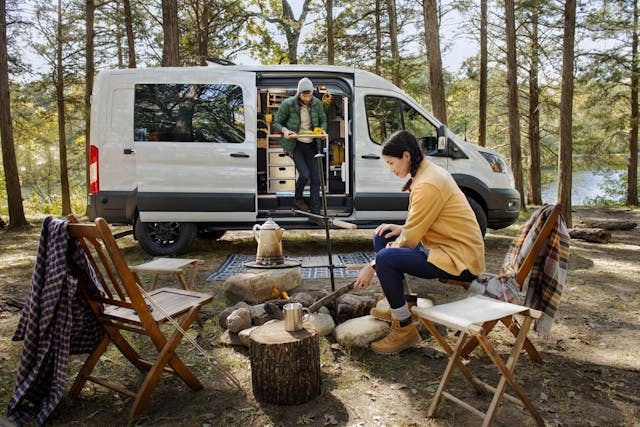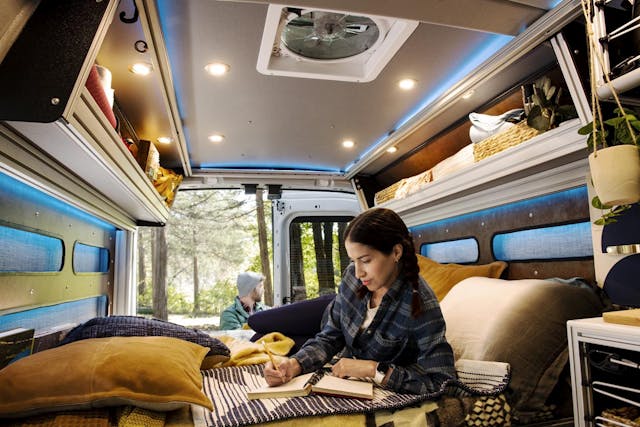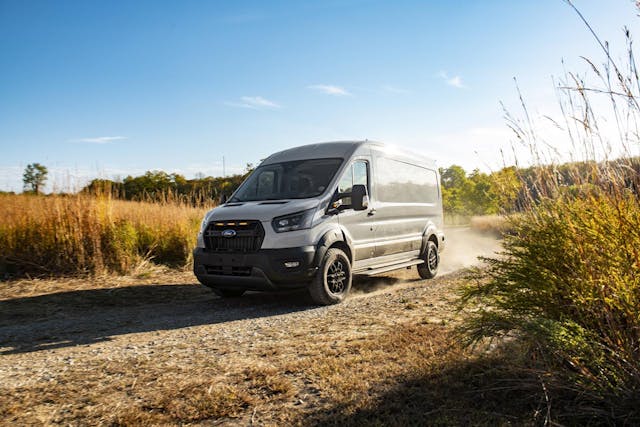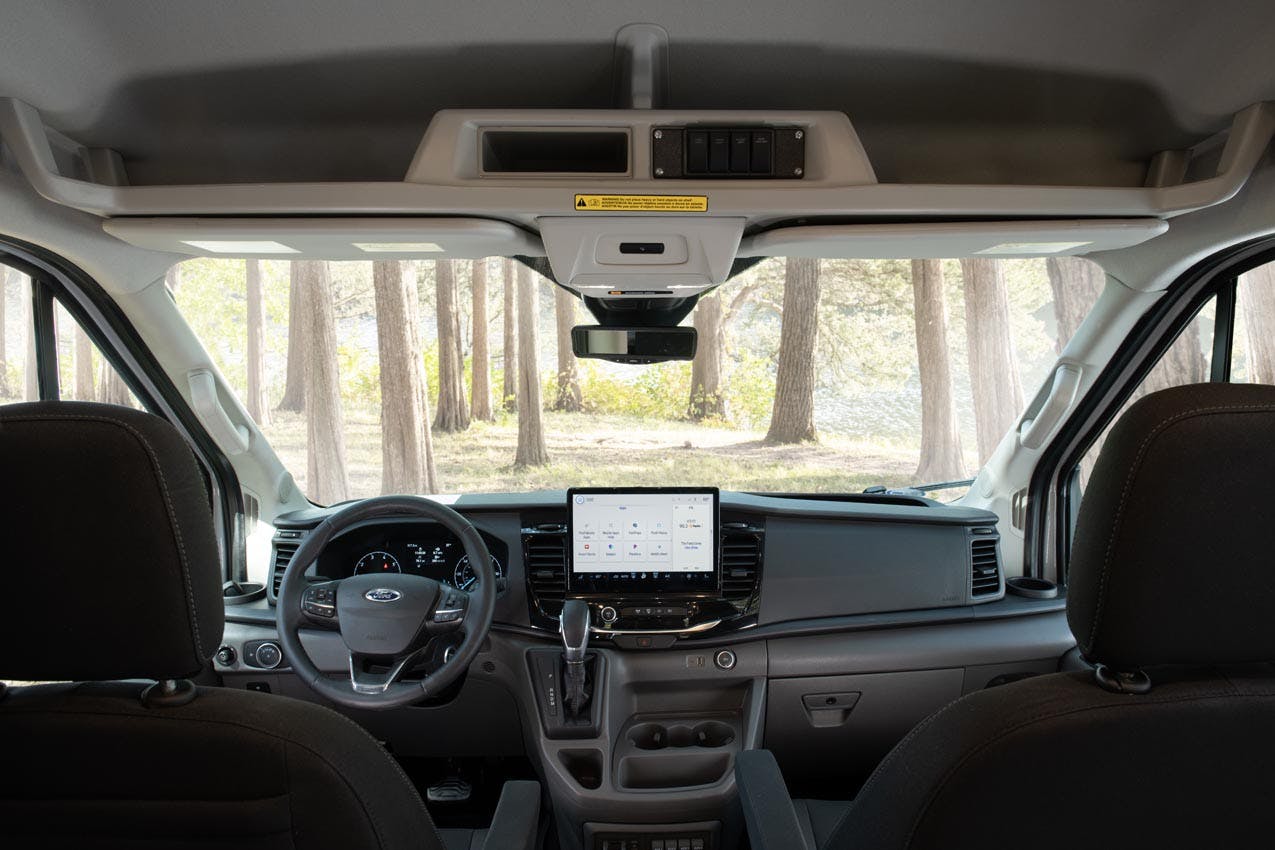Ford’s rugged Transit Trail is a blank canvas tailored for vanlife
Almost as soon as the current Transit went on sale in North America in late 2014, up-fitters and DIY-minded folk began taking this deeply utilitarian machine and rigging it for sleeping, cooking, and general subsistence on the road. At long last, Ford has decided to not just tolerate the #VanLife fans but to wholly embrace them. Enter the Transit Trail.
Tortured though the hashtag may be in the modern social-media age, living out of a van is still very much en vogue. The RV industry is still riding pandemic stir-craziness to new heights, and with remote working now a fixture of our society, these new heights may just become the new norm. Class B motorhomes, the category into which these work-vans-turned-mobile-homes fall, is the fastest growing segment in the industry. Couple that with America’s desire to get off the beaten path and chase adventures of all shapes and sizes, and a factory-backed, camper-friendly Transit is a natural endpoint. Market, meet moment.

The Trail version takes everything about the existing base Transit and hones it to the needs of these unorthodox buyers. Ride height is up 3.5 inches thanks to chunky, 30.5-inch Goodyear all-terrain tires and a body lift. The track width grows 2.75 inches thanks to new, 16-inch alloy wheels plus those meatier tires. There’s a skid plate–style front bumper to protect the van’s chin over rockier terrain and slider-style side-steps to keep those rockers from getting pinched. The standard Explorer-based all-wheel-drive system features an intelligent transfer case that automatically shuffles power to the front axle when it detects slippage. The 3.5-liter EcoBoost twin-turbo V-6 sends 310 hp and 400 lb-ft of torque through a 10-speed automatic. Thanks to a standard heavy-duty trailer package, even the weakest of Transit Trails—the extended-length, high-roof model—can tow up to 6200 pounds. The strongest can drag 6500.
The tweaks result in a tough-looking box that looks capable of reaching the desert trailheads, secluded beach coves, and forested mountaintops that adventure-seeking vanners favor. Those creative customers usually fit their rigs with sleeping quarters, and Ford is happy to leave that job to them. The Transit Trail is not a Blue Oval-branded entrant into the full-fledged van battle; it’s merely an “upfit-ready” platform.
And that’s not a knock. As Ford sees it, there are two types of crowds chasing the same boxed-living endgame: DIYers and those who will simply call an upfitter, placing an order for that firm’s next spec build. The folks at Ford Pro, Dearborn’s commercial and fleet vehicle business, know that the Transit works best when pitched as a “blank canvas” for would-be customers. In this case, the Transit Trail’s proposition is “blank canvas with more ground clearance.”
Through extensive conversations with those passionate about building their own van residence, Ford Pro’s product planners figured out a host of ways to make the DIY experience friendlier by handling some of the less-pleasant or daunting jobs in the Kansas City, Kansas factory where these will be assembled. To wit: DIYers don’t like cutting holes in their lovely new machine’s roof to install devices and vents to aid in airflow, so the Transit Trail will come with the option for a pre-cut hole and a roof vent fan. The inside features specific drillable areas for cabinets, tables, beds, and other staples of vanlife kit. There’s an upfitter package that will tack on high-capacity switches and an auxiliary fuse panel for extra accessories and lights, and a dual-alternator option to power the Transit Trail’s standard dual-battery setup.

If you’re not as confident with your rig-building skills, and would like a guarantee that the bed won’t collapse on night one, perhaps an upfitted van is more your speed. Ford has been working closely with outfits such as Missouri-based Vandoit since the beginning of the Transit Trail project to learn which touches the firms most wanted to see on a purpose-built platform. Those pre-cut holes and mounting points are for aftermarket shops as much as they are for DIY customers, and the outfits are stoked: Tim Baughman, Ford Pro’s North American general manager, said that one upfitting company got so excited during development discussions with Ford that it offered to purchase the entire first year’s worth of Transit Trails to start building out into camping-ready vehicles!
Whether they want sawdust on their hands or not, every Transit Trail buyer will be able service their rig at any of the Ford dealership network’s 3000 maintenance centers nationwide. If something happens while out and about, Fords growing fleet of more than 800 mobile service vans can hopefully get close enough to sort things out.

The price for this extra off-road tech, capability, and potential? Ford says the Transit Trail will start at $65,975 excluding destination. That will buy you the platform upon which to paint your wildest vanlife dreams. It may seem a bit steep, but given that a decent upfitter build can easily clear six figures, that price still leaves plenty of wiggle room for most of the buyers who would scoop a brand new product to build out on a tighter budget. Whether they choose to bust out the sawzall and tape measure to keep costs down or splash for an expert-built sanctuary on wheels, Ford’s Transit Trail looks like an ideal place to start your vanlife pursuits.
All you need now is a catchy Instagram handle.





Too bad it doesn’t have low range.
But neither does the new exploder .
Gonna take a lot to get people away from the sprinter though .
Let me guess ; ford sells a turbo diesel version everywhere but North America ?